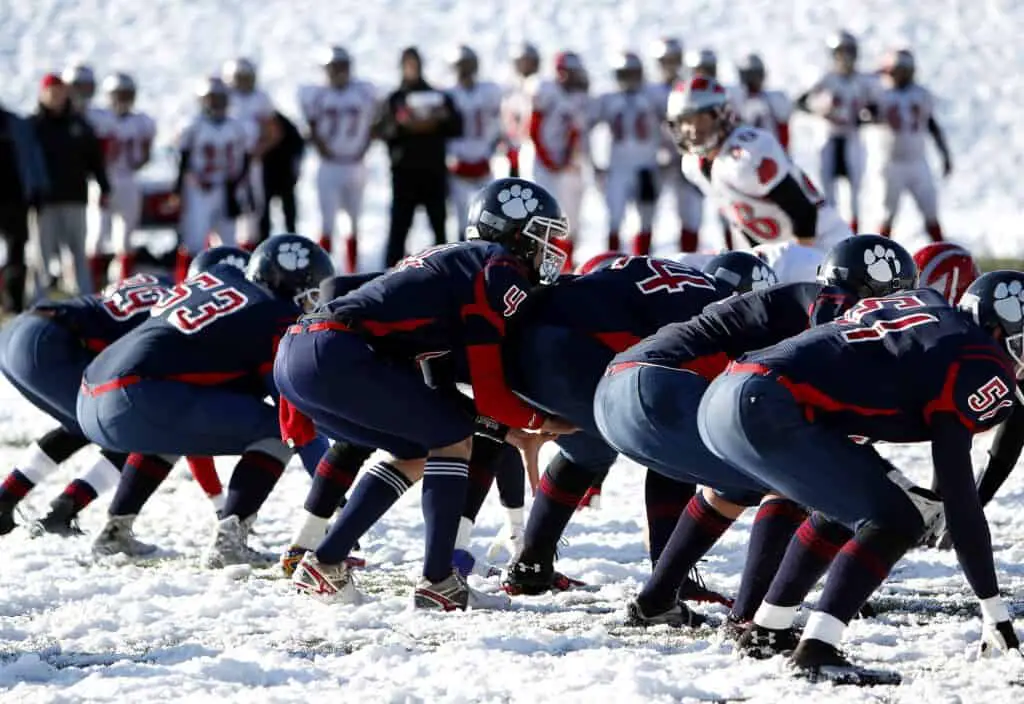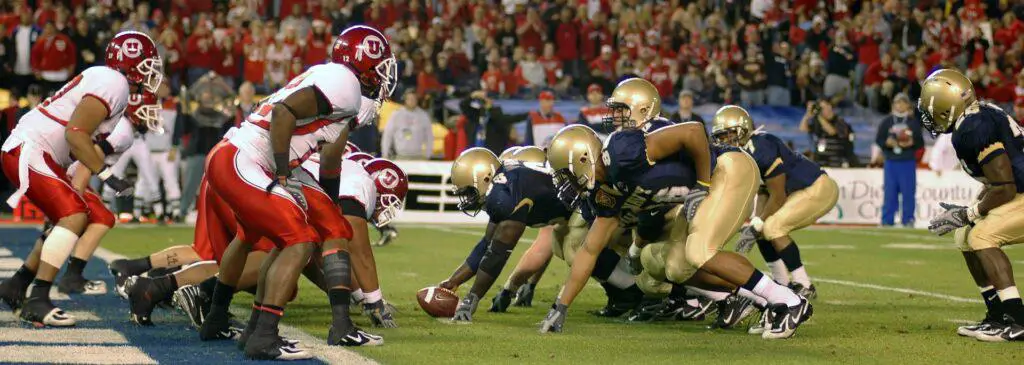The brief answer for these terms as below:
- Running back is a wide term, fullbacks, halfbacks, and tailbacks all arrange as running backs.
- Fullbacks are commonly greater/slower/and better blockers while frequently arranging as a lead blocker for the halfback.
- Halfback and tailbacks are practically interchangeable and are the folks that generally do the real running.
Click here to view and buy great American football gadgets.

Now, let us look at them in detail.
Fullback
In most college and expert football plans, fullbacks convey the ball rarely. As of now, they are essentially used to help the hostile linemen in hindering. Forward extensively running plays, the fullback pushes the halfback, attempting to obstruct anticipated tacklers before they reach the ball transporter. Fullbacks are here and there utilized in passing plays, even though they regularly secure the quarterback. Fullbacks are running backs, however today the expression “running back” is typically utilized in alluding to the halfback or tailback. Even though fullbacks as of now are once in a while utilized as ball transporters, some time ago they ran the ball as now and again as running backs.
In secondary school football, where the offenses are more straightforward and player sizes fluctuate significantly, fullbacks are still oftentimes utilized as ball transporters. In secondary school football and some of the time in college football, a plan known as the “Triple Option” uses the fullback as a ball transporter. The fullback is viewed as an essential ball transporter in this plan and assumes a novel function by building up an inside running danger. Triple Option plot fullbacks require astounding ball conveying aptitudes and utilize an industrious running style, however, regularly do not have the accepting abilities of their partners in different plans. College groups, for example, the Navy and Air Force have utilized the triple alternative plan with progress.
While in years past the fullback arranged on the field for pretty much every hostile play, groups regularly picked to supplant the fullback with an extra-wide beneficiary or a tight end in present-day football. Fullbacks in the National Football League seldom will convey or get the ball since they are utilized only as blockers. Their ability and incentive to a group are generally decided by the accomplishment of the group’s halfback or by how frequently the group’s quarterback is sacked, like how hostile linemen are judged. Fullbacks are likewise still utilized periodically as rushers on plays when a short increase is required for a first-down or score, as they are enormous and amazing and along these lines viable at getting through the line for a short separation. Jim Brown, Marion Motley, Franco Harris, and Larry Csonka were extraordinary fullbacks and a portion of the pioneers. More present-day models incorporate Mike Alstott and Tony Richardson.

Halfback/ Tailback
The halfback or tailback position is one of the more breathtaking situations on the field, as it is frequently essential in both the passing and running assault. A balanced halfback is generally seen as a necessity for a group’s prosperity. He is answerable for conveying the ball on most running plays, and may much of the time be utilized as a beneficiary on short passing plays. In the present game, a powerful halfback must have a predominant mix of both briskness and deftness as a sprinter, just as sure hands and smart vision upfield as a collector. An ever-increasing number of quarterbacks rely upon halfbacks as a dump-off recipient when essential targets downfield are secured. Periodically, they line up as extra-wide beneficiaries. When not serving both of these capacities, the essential obligation of a halfback is to help the hostile linemen in obstructing, either to secure the quarterback or another player conveying the football. On some uncommon events, running backs are utilized to pass the ball on a halfback alternative play or halfback pass.
No situation in Canadian/American football can play out his obligations effectively without the assistance of different players. Like the wide beneficiary, who by and large can’t make huge plays without the quarterback passing to him (except for the end-around or an opposite), the running back almost in every case needs great impeding from the hostile line to effectively pick up yardage. Additionally, a running back will by and large have more surging endeavors than a recipient will have gatherings, which is essential because a beneficiary must catch a pass to acquire a gathering, while a running back ordinarily takes an immediate handoff or short pitch from the quarterback before enrolling a hurrying endeavor.
Note that the distinction between halfback and tailback is essentially the situation of the major part in the group’s hostile arrangement. The halfback lines up somewhere between the line of scrimmage and the fullback (likewise, quarterbacks line up a fourth of the separation between the line of scrimmage and the fullback). Since the halfback is generally the group’s principle ball transporter (while the fullback is fundamentally a blocker), numerous mentors decide to situate the halfback behind the fullback (at the “last part” of the development). For this situation, the halfback turns into a tailback.
Running back
A running back (RB) is the situation of a player on an American or Canadian football team who for the most part lines up in the hostile backfield. The essential parts of a running back are to get handoffs from the quarterback for a surging play, to get passes from out of the backfield, and to obstruct.
There are normally a couple of running backs on the field for a given play, contingent upon the hostile arrangement. A running back might be a halfback (HB for short, in specific settings likewise alluded to as a tailback) or a fullback (FB).
Conclusion
Initially, the quarter, half, and fullbacks were conveyed a quarter, half, and full yard behind the line of scrimmage.
The quarterback has the most adaptable function of the three “back” types since he can either pass the ball or run if the guard has held its men back to cover his “beneficiaries.”
The halfbacks should utilize speed to rush to either stopping point, either past the (end run) or behind the tackle (off tackle).
The fullback should charge through the center of the contradicting line by utilizing power. This should be possible effectively just if past passing or end-running plays made the safeguard debilitate the focal point of the line to strengthen their flanks. On the other hand, an ineffective “draw play” by a fullback may “set up” a flanking running or passing play. Something else, a fullback might be a blocker for a quarterback who needs to pass or a halfback who needs to hurry aside.
People also ask
What is the difference between a fullback and a halfback in football?
Halfback, running back, and fullback are altogether classes of running backs. The key is to perceive that a fullback by and large fills in as a blocker, while halfbacks or running backs fill in as the chief ball-transporters. A fullback ensures the halfback or running back and goes about as a blocker.
Why is a running back called a halfback?
Since most hostile developments have just a couple of running backs, the first assignments don’t mean so a lot, as the fullback is currently normally a lead blocker (in fact a halfback), while the halfback or tailback (called such because he remains at the “tail” of the I) lines up behind the fullback.
What exists the duty of a fullback in football?
Commonly, fullbacks are bigger than halfbacks and in most hostile plans their obligations are part between power running, pass getting, and obstructing for both the quarterback and the other running back.
Do teams still use fullbacks?
As of now, numerous groups have no obvious fullback at all on their list, and when they do, he is seeing fewer and fewer snaps. Much of the time, groups have been going to the adaptable H-back instead of a genuine NFL fullback. … Groups are additionally spreading to utilize more one-back three-wide sets or running behind two-tight end arrangements.